Kirby Larson's Blog, page 41
December 14, 2012
Friend Friday
My friendship with Tom Angleberger started with a fan letter to him after reading The Strange Case of the Origami Yoda. Not only was that book full of heart and humor, it was as if Tom had lived in my house when my son and his friends were in 6th & 7th grade. Obviously, I wasn't the only huge fan of Origami Yoda, nor the only one asking for another book about Tommy, Kellen, Harvey and Dwight (well, maybe not Harvey). And being the obliging kind of guy he is, Tom wrote Darth Paper Strikes Back. And still that wasn't enough for his fans! Hence, the newest book:
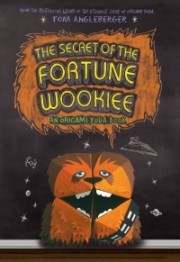
I was particularly tickled to find my name in the Acknowledgments. That Tom. He is one all right guy! Rumor has it that a fourth Origami Yoda book is in the works, this time featuring everyone's favorite droid. Now if I could only convince him to write a sequel to Horton Halfpott. . .

I was particularly tickled to find my name in the Acknowledgments. That Tom. He is one all right guy! Rumor has it that a fourth Origami Yoda book is in the works, this time featuring everyone's favorite droid. Now if I could only convince him to write a sequel to Horton Halfpott. . .
Published on December 14, 2012 07:00
December 13, 2012
Thursday's Thought
“It is much easier to be brave if you do not know everything.”
Lois Lowry
Lois Lowry
Published on December 13, 2012 07:30
December 11, 2012
Teacher Tuesday
Here's a slightly different take on the Teacher Tuesday feature. It begins with a lovely email Mary Nethery and I received in early November:
Dear Kirby and Mary,
Thanks for the beautiful collaboration of The Two Bobbies. I work with National Dance Institute in NYC, and this year, we are creating dances and shows about NOLA. I am hoping to create a dance utilizing the story of the two Bobbies on young dancers.
That said, I teach nearly 700 kids a week, in NY and Hoboken, NJ. Both communities were affected by our recent Hurricane Sandy. I have been digging deep for ways to help the children cope with massive amounts of loss and expressing their feelings. My boyfriend, who is trained a psychologist and I are going to write a lesson plan, suggesting use of your book, using a dance therapy approach. We will post it for free use and sharing on my blog.
Thanks for your meaningful timeless work!
Jenn
This was a particularly meaningful email on many levels. First, Mary and I continue to be humbled by the way the Two Bobs still finds new readers -- and new hearts to touch -- four years after publication. And we were thrilled at this creative way to use our story to inspire healing (especially apropos to Mary, a former dancer herself). We've back and forthed a bit with Jenn and she was kind enough to send us some photos. They speak for themselves. Enjoy!
 Two kinders as Bobbie and Bob Cat
Two kinders as Bobbie and Bob Cat
 Bobbie and Bob Cat reconnected at Celebration Station
Bobbie and Bob Cat reconnected at Celebration Station
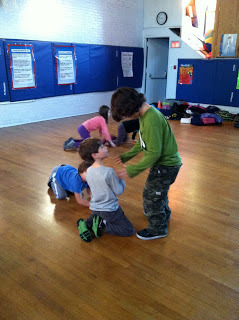 First graders favorite part of story--learning that Bob Cat is blind
First graders favorite part of story--learning that Bob Cat is blind
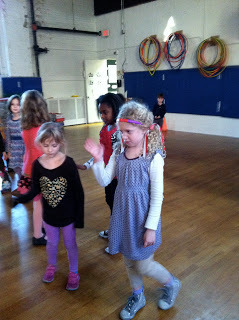 Showing how the Bobbies felt when they were left on the front porch
Showing how the Bobbies felt when they were left on the front porch
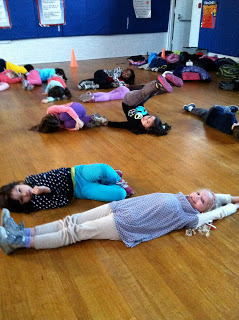 Children as the littered streets, after the hurricane
Children as the littered streets, after the hurricane
Learn more about Jenn's work with National Dance Institute here.
Dear Kirby and Mary,
Thanks for the beautiful collaboration of The Two Bobbies. I work with National Dance Institute in NYC, and this year, we are creating dances and shows about NOLA. I am hoping to create a dance utilizing the story of the two Bobbies on young dancers.
That said, I teach nearly 700 kids a week, in NY and Hoboken, NJ. Both communities were affected by our recent Hurricane Sandy. I have been digging deep for ways to help the children cope with massive amounts of loss and expressing their feelings. My boyfriend, who is trained a psychologist and I are going to write a lesson plan, suggesting use of your book, using a dance therapy approach. We will post it for free use and sharing on my blog.
Thanks for your meaningful timeless work!
Jenn
This was a particularly meaningful email on many levels. First, Mary and I continue to be humbled by the way the Two Bobs still finds new readers -- and new hearts to touch -- four years after publication. And we were thrilled at this creative way to use our story to inspire healing (especially apropos to Mary, a former dancer herself). We've back and forthed a bit with Jenn and she was kind enough to send us some photos. They speak for themselves. Enjoy!
 Two kinders as Bobbie and Bob Cat
Two kinders as Bobbie and Bob Cat Bobbie and Bob Cat reconnected at Celebration Station
Bobbie and Bob Cat reconnected at Celebration Station First graders favorite part of story--learning that Bob Cat is blind
First graders favorite part of story--learning that Bob Cat is blind Showing how the Bobbies felt when they were left on the front porch
Showing how the Bobbies felt when they were left on the front porch Children as the littered streets, after the hurricane
Children as the littered streets, after the hurricaneLearn more about Jenn's work with National Dance Institute here.
Published on December 11, 2012 07:00
December 7, 2012
Friend Friday
I am so pleased to introduce you to Holly Niner. She and I met eons ago at a book festival in Kentucky. We hit it right off and, in fact, had so much fun together, I conned her into staying over an additional night so we could keep hanging out!
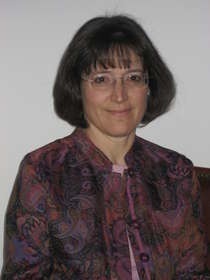
Holly's got a new book coming out, Jackson's Noisy Nighttime Guests, (no pub date yet) which is fabulous news. I wanted you to meet Holly because her story is the story of so many of us, trying to carve out a career in writing books for children and young adults.
What launched you as a writer?
I think my writing started with reading. I've always been a reader from the flashlight in bed as a child to sneaking a few pages in the bathroom when my kids were small. When you fall in love with stories I think you wish you could write one someone else would fall in love with. When my children came along reading to them was huge (good behavior earned extra books read at bed), but I didn't make up stories to tell them; actually my husband did.
So what moved you from passionate reader to writer?
I can't remember why, although maybe because I had dabbled in poetry, my mom sent me info about the Institute of Children's Literature (ICL) class. I did the class (graduated 1992) when my kids were preschool age and found I did enjoy writing and I did have stories come to mind. What I didn't have was a good grasp of the business of writing or a thick skin. When rejections piled up and some major life changes happened I stopped.
This is a story I've heard before. It is discouraging at times. What got you going again?
When we moved to Fort Wayne, our children were in first and second grade and I went back to work PRN, which is as needed, as a speech therapist in long term care. So I was able to work only while they were in school and not work vacations, holidays etc. I generally worked 6 hrs/3 days a week. Life was busy with work, school volunteering etc so I didn't think much about writing. Then Medicare changed how it was paying for services in long term care, and my work dried up.
Since we did not want me to work a full time or even part time job because it is not flexible and being there for the kids was important, I suddenly had a lot of time on my hands. I started thinking about writing again, but decided this time I would learn more about the business side. When I began writing I had toddlers and so was only writing in the wee hours. Now that they were older, I had days while they were at school to devote to it. I also credit Alphasmart. Have you ever seen one? Just a tiny light word processor that ran on AA batteries. With it I could write while waiting at piano lessons etc. I'm not as good at using my time now, as I was then!
What changed when you started up again?
As I mentioned, I had taken time to educate myself about the business of writing, which included targeting my submissions more carefully, among other things. I began to get the encouraging rejections from magazine submissions, then some magazine acceptances and then my first book offer in 2003, from Albert Whitman. The next offer, also from Whitman, followed quickly. So I thought I had opened the door, only to find I didn't even have my foot in it. My next book offer did not come until 2012! And that offer was for a manuscript I sent in 2009; that Shari and I worked on in 2009. But it was 2012 before her small press was able to make an offer.
Wow! Talk about persistence. Tell us about that time.
During the years between 2003 and 2012, I had an agent and lost an agent, added to my growing pile of well over 200 rejections (book and magazine), and accumulated a stack of picture book manuscripts - some I still love, some I don't! Sometimes when I have time for writing I'm frozen: should I write, learn more about writing, research markets, re-submit manuscripts?
Any words of encouragement/insight?
Writing is often discouraging and having special writing friends has helped me persevere when I was ready to quit. Such friends are always there to listen, encourage and suggest ways I might move forward.
And you never know where you might meet them -- sometimes, even in the restaurant of a Holiday Inn in Bowling Green, Kentucky!
Thanks for sharing your story of determination, Holly. And we can't wait to celebrate that new book with you!

Holly's got a new book coming out, Jackson's Noisy Nighttime Guests, (no pub date yet) which is fabulous news. I wanted you to meet Holly because her story is the story of so many of us, trying to carve out a career in writing books for children and young adults.
What launched you as a writer?
I think my writing started with reading. I've always been a reader from the flashlight in bed as a child to sneaking a few pages in the bathroom when my kids were small. When you fall in love with stories I think you wish you could write one someone else would fall in love with. When my children came along reading to them was huge (good behavior earned extra books read at bed), but I didn't make up stories to tell them; actually my husband did.
So what moved you from passionate reader to writer?
I can't remember why, although maybe because I had dabbled in poetry, my mom sent me info about the Institute of Children's Literature (ICL) class. I did the class (graduated 1992) when my kids were preschool age and found I did enjoy writing and I did have stories come to mind. What I didn't have was a good grasp of the business of writing or a thick skin. When rejections piled up and some major life changes happened I stopped.
This is a story I've heard before. It is discouraging at times. What got you going again?
When we moved to Fort Wayne, our children were in first and second grade and I went back to work PRN, which is as needed, as a speech therapist in long term care. So I was able to work only while they were in school and not work vacations, holidays etc. I generally worked 6 hrs/3 days a week. Life was busy with work, school volunteering etc so I didn't think much about writing. Then Medicare changed how it was paying for services in long term care, and my work dried up.
Since we did not want me to work a full time or even part time job because it is not flexible and being there for the kids was important, I suddenly had a lot of time on my hands. I started thinking about writing again, but decided this time I would learn more about the business side. When I began writing I had toddlers and so was only writing in the wee hours. Now that they were older, I had days while they were at school to devote to it. I also credit Alphasmart. Have you ever seen one? Just a tiny light word processor that ran on AA batteries. With it I could write while waiting at piano lessons etc. I'm not as good at using my time now, as I was then!
What changed when you started up again?
As I mentioned, I had taken time to educate myself about the business of writing, which included targeting my submissions more carefully, among other things. I began to get the encouraging rejections from magazine submissions, then some magazine acceptances and then my first book offer in 2003, from Albert Whitman. The next offer, also from Whitman, followed quickly. So I thought I had opened the door, only to find I didn't even have my foot in it. My next book offer did not come until 2012! And that offer was for a manuscript I sent in 2009; that Shari and I worked on in 2009. But it was 2012 before her small press was able to make an offer.
Wow! Talk about persistence. Tell us about that time.
During the years between 2003 and 2012, I had an agent and lost an agent, added to my growing pile of well over 200 rejections (book and magazine), and accumulated a stack of picture book manuscripts - some I still love, some I don't! Sometimes when I have time for writing I'm frozen: should I write, learn more about writing, research markets, re-submit manuscripts?
Any words of encouragement/insight?
Writing is often discouraging and having special writing friends has helped me persevere when I was ready to quit. Such friends are always there to listen, encourage and suggest ways I might move forward.
And you never know where you might meet them -- sometimes, even in the restaurant of a Holiday Inn in Bowling Green, Kentucky!
Thanks for sharing your story of determination, Holly. And we can't wait to celebrate that new book with you!
Published on December 07, 2012 07:00
December 6, 2012
Thursday's Thought
"I want to remake the world; anything less is not worth the trouble.”
Karen Cushman
Karen Cushman
Published on December 06, 2012 07:30
December 4, 2012
Teacher Tuesday
I first "met" Will Strait when he arranged a Skype visit with a few of his classes at Spartanburg Day School, in Spartanburg, South Carolina. The school serves K-12 students, but Will primarily works with K-6. I had a thoroughly delightful cross-country conversation and, though I didn't forget Will, I promptly forgot where he was teaching. So, when I arrived to present at the South Carolina Association of School Librarians conference a year or so ago, I was completely surprised to discover that Will would be introducing me! He is even more fun in person.
Will was a bit hesitant when I first approached him about participating in Teacher Tuesday, but he was inspired by Colby Sharp's kick-off interview about read-alouds, specifically Fig Pudding, by Ralph Fletcher. Like Colby, Will is equally passionate about a particular title -- but I'll let him tell you about that himself.
First, a Teacher Tuesday tradition: a peek into Will's past!
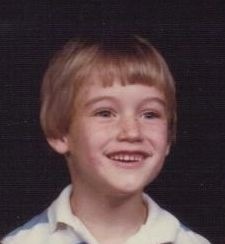 Little Will looking forward to his first read-aloud!
Little Will looking forward to his first read-aloud!
Favorite school lunch as a kid: My mom packed my lunch for years, and I loved a particularly southern delicacy: peanut butter and banana with mayonnaise. Some people think that all mayonnaise is created equal, but most from South Carolina will assure you that the only true kind is Duke’s.Best friend in grade school: Craig Wactor--1-4Times you were the new kid in school: Just once. When my family moved from the town/suburb of West Columbia, SC to the genuinely small town of Moncks Corner, SC. Most of the kids had been attending school with one another since kindergarten. There was a bit of culture shock, but I think any new school would have been difficult for I was a shy, bookish kid.Teacher who inspired you to stretch:I had a number of teachers who sought to push me. Most were not overly successful because I was able to skate by with minimum effort for quite a while. There were a few who managed to succeed in getting me to push myself, mostly by getting me excited about a topic I was already into, such as history or literature/reading. I think one of the most inspiring teachers was a college professor, Dr. Gordon Ross, I had at Winthrop. He was, seemingly, one of the happiest people I have ever met, and he cared so much about English literature and his students that it made me only want to turn in my finest work to him.The one thing you always wished you could do in grade school but never achieved: Snap my fingers. Sadly, I did not master this essential skill until I was in college.
Will, you agreed to be interviewed after reading the Teacher Tuesday post with Colby Sharp, in which he talked about his favorite read-aloud, Fig Pudding. You are equally passionate about your favorite read-aloud for 4th graders, The SOS File by Betsy Byars, Betsy Duffey, and Laurie Myers.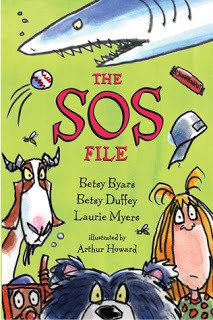
How and where did you first discover this title?I found this book because I was searching for read-alouds for a particularly jaded group of fourth graders I had my very first year as a school librarian. Several of the books I had read them had fallen disastrously flat. I was looking for something that would be interesting to a 4th grade class and the variety of interests that it contains. I think I discovered it in one of those Amazon lists that someone had made. I knew Betsy Byars from her fantastic, Newbery-winning Summer of the Swans, and I thought I would give the book a try. I started reading it to students my second year as a school librarian, and it has been a standby ever since.
Obviously, a book needs to speak to you in order for you to want to read it to your class. Talk about the ways in which this book spoke to you.What I appreciate about this book is how authentic the characters’ voices in the book are. I also really enjoyed how it is quite simply a fun book. The book doesn’t pretend to be a masterpiece or have some grand theme. In direct and clear language, the book tells entertaining stories about a variety of kids. There is one serious story stuck in the middle, but it is a happy story, rather than a sad one. My biggest complaint about The SOS File is that there aren’t a hundred books out there just like it.
Most 4th graders are very competent readers and could read The SOS File on their own. Why do you believe in reading aloud to students?I believe in reading aloud to students for a number of reasons. One of the main ones is that it shows an adult enjoying a book in a very obvious fashion. It’s one of the reasons I try my hardest never to read something I don’t find highly enjoyable, because it shows. I want students to have as many pleasant memories tied to books as possible.
Aside from the touchy-feely aspects of why I like to read aloud to students there is a significant amount of literature that shows its benefits for attention span, listening skills, and vocabulary acquisition. Anecdotally, I have seen all of these benefits in my daughter.
Do you have particular read aloud methods/techniques?I vary my techniques depending on the book I’m reading and who I’m reading it to. I do a lot more stopping and starting and questioning with younger readers and picture books. With longer works, I tend to stop a lot less, only on a part that might be confusing to students. With older students, with a chapter book like The SOS File, I work very hard to establish eye contact, to not spend all my time staring at the book. It’s something that has taken a great deal of practice to improve, but hours and hours of reading to my daughter have helped.
What impacts does this book have on your students? I think the main thing most students take away from the book is the excitement of wondering what the next story will be about. The students all study the cover and notice the shark first. “Will the next story be about the shark?” they always want to know. In the past, when I have taken a break from the book, they always try to check out my copy or get me to tell them about the other stories.
You extend your students’ experience with this book through a writing exercise. Tell us about that exercise.It is a simple creative writing exercise. Students get to write their own entry into the SOS file. We spend a library session writing our own entries. The next week we take turns reading them aloud and sharing them with one another. It is always an entertaining time. They really enjoy the opportunity to write a story without worrying about whether it will be graded or not. This year I had stories ranging from having a bad MineCraft experience to almost being thrown from a horse.
We know that The SOS File is your favorite read aloud; what other books do you read aloud to your students? Recommendations, please!That’s a surprisingly tough question. I could literally go on all day. One of my particular favorites for K-1st are the Elephant and Piggie books by Mo Willems. These books are a towering achievement in children’s literature: incredibly simple, yet sublime. Two of the best are We Are in a Book and Can I Play Too? Last year, with 4th graders, I had a lot of luck with The Christmas Genie by Dan Gutman.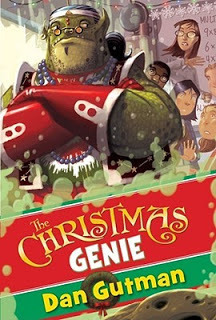
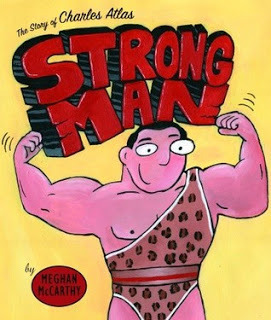
I Want My Hat Back by Jon Klassen has been a hit every time I have tried it, with multiple age groups. I had several eighth-graders fighting over our copy the other day, when they had the opportunity to read to some four and five year olds.
Publishers have released a lot of fantastic non-fiction picture books in the last few years. Some of my favorites, from a read-aloud perspective, are Queen of the Falls by Chris van Allsburg, Balloons Over Broadway by Melissa Sweet, Into the Deep by William Beebe, and Strong Man by Meghan McCarthy. It is very easy to extend all of these books with multimedia, additional reading, and research.
Let’s see, don’t forget some of the classics that still work today: Robert McCloskey’s books still hold up, in particular, Make Way for Ducklings and Blueberries for Sal. If you haven’t explored the odd wonders that are William Steig’s picture books, lately, you really should.
Books with just the right amount of grit that do not talk down to kids.
What else would you like to tell us about reading aloud and/or about reading aloud this particular title?I’m sure everyone reading your blog probably has a similar opinion, but I will share it anyway. If you have children, take the time to read to them every day. You will not regret it.
And, as we are heading into the holiday season, you can make it even easier to read to the kids in your lives by gifting them with some brand-new books*, perhaps even one or two of those Will has recommended above!
Thanks to Will for a lively and thoughtful post. I love his suggestions for read-aloud techniques; similar ideas can be found in Mem Fox's wonderful book, Reading Magic: Why Reading Aloud to Our Children Will Change Their Lives Forever.
* if you are looking for some great book gift ideas, check out Mother Reader's blog!

Will was a bit hesitant when I first approached him about participating in Teacher Tuesday, but he was inspired by Colby Sharp's kick-off interview about read-alouds, specifically Fig Pudding, by Ralph Fletcher. Like Colby, Will is equally passionate about a particular title -- but I'll let him tell you about that himself.
First, a Teacher Tuesday tradition: a peek into Will's past!
 Little Will looking forward to his first read-aloud!
Little Will looking forward to his first read-aloud!Favorite school lunch as a kid: My mom packed my lunch for years, and I loved a particularly southern delicacy: peanut butter and banana with mayonnaise. Some people think that all mayonnaise is created equal, but most from South Carolina will assure you that the only true kind is Duke’s.Best friend in grade school: Craig Wactor--1-4Times you were the new kid in school: Just once. When my family moved from the town/suburb of West Columbia, SC to the genuinely small town of Moncks Corner, SC. Most of the kids had been attending school with one another since kindergarten. There was a bit of culture shock, but I think any new school would have been difficult for I was a shy, bookish kid.Teacher who inspired you to stretch:I had a number of teachers who sought to push me. Most were not overly successful because I was able to skate by with minimum effort for quite a while. There were a few who managed to succeed in getting me to push myself, mostly by getting me excited about a topic I was already into, such as history or literature/reading. I think one of the most inspiring teachers was a college professor, Dr. Gordon Ross, I had at Winthrop. He was, seemingly, one of the happiest people I have ever met, and he cared so much about English literature and his students that it made me only want to turn in my finest work to him.The one thing you always wished you could do in grade school but never achieved: Snap my fingers. Sadly, I did not master this essential skill until I was in college.
Will, you agreed to be interviewed after reading the Teacher Tuesday post with Colby Sharp, in which he talked about his favorite read-aloud, Fig Pudding. You are equally passionate about your favorite read-aloud for 4th graders, The SOS File by Betsy Byars, Betsy Duffey, and Laurie Myers.

How and where did you first discover this title?I found this book because I was searching for read-alouds for a particularly jaded group of fourth graders I had my very first year as a school librarian. Several of the books I had read them had fallen disastrously flat. I was looking for something that would be interesting to a 4th grade class and the variety of interests that it contains. I think I discovered it in one of those Amazon lists that someone had made. I knew Betsy Byars from her fantastic, Newbery-winning Summer of the Swans, and I thought I would give the book a try. I started reading it to students my second year as a school librarian, and it has been a standby ever since.
Obviously, a book needs to speak to you in order for you to want to read it to your class. Talk about the ways in which this book spoke to you.What I appreciate about this book is how authentic the characters’ voices in the book are. I also really enjoyed how it is quite simply a fun book. The book doesn’t pretend to be a masterpiece or have some grand theme. In direct and clear language, the book tells entertaining stories about a variety of kids. There is one serious story stuck in the middle, but it is a happy story, rather than a sad one. My biggest complaint about The SOS File is that there aren’t a hundred books out there just like it.
Most 4th graders are very competent readers and could read The SOS File on their own. Why do you believe in reading aloud to students?I believe in reading aloud to students for a number of reasons. One of the main ones is that it shows an adult enjoying a book in a very obvious fashion. It’s one of the reasons I try my hardest never to read something I don’t find highly enjoyable, because it shows. I want students to have as many pleasant memories tied to books as possible.
Aside from the touchy-feely aspects of why I like to read aloud to students there is a significant amount of literature that shows its benefits for attention span, listening skills, and vocabulary acquisition. Anecdotally, I have seen all of these benefits in my daughter.
Do you have particular read aloud methods/techniques?I vary my techniques depending on the book I’m reading and who I’m reading it to. I do a lot more stopping and starting and questioning with younger readers and picture books. With longer works, I tend to stop a lot less, only on a part that might be confusing to students. With older students, with a chapter book like The SOS File, I work very hard to establish eye contact, to not spend all my time staring at the book. It’s something that has taken a great deal of practice to improve, but hours and hours of reading to my daughter have helped.
What impacts does this book have on your students? I think the main thing most students take away from the book is the excitement of wondering what the next story will be about. The students all study the cover and notice the shark first. “Will the next story be about the shark?” they always want to know. In the past, when I have taken a break from the book, they always try to check out my copy or get me to tell them about the other stories.
You extend your students’ experience with this book through a writing exercise. Tell us about that exercise.It is a simple creative writing exercise. Students get to write their own entry into the SOS file. We spend a library session writing our own entries. The next week we take turns reading them aloud and sharing them with one another. It is always an entertaining time. They really enjoy the opportunity to write a story without worrying about whether it will be graded or not. This year I had stories ranging from having a bad MineCraft experience to almost being thrown from a horse.
We know that The SOS File is your favorite read aloud; what other books do you read aloud to your students? Recommendations, please!That’s a surprisingly tough question. I could literally go on all day. One of my particular favorites for K-1st are the Elephant and Piggie books by Mo Willems. These books are a towering achievement in children’s literature: incredibly simple, yet sublime. Two of the best are We Are in a Book and Can I Play Too? Last year, with 4th graders, I had a lot of luck with The Christmas Genie by Dan Gutman.


I Want My Hat Back by Jon Klassen has been a hit every time I have tried it, with multiple age groups. I had several eighth-graders fighting over our copy the other day, when they had the opportunity to read to some four and five year olds.
Publishers have released a lot of fantastic non-fiction picture books in the last few years. Some of my favorites, from a read-aloud perspective, are Queen of the Falls by Chris van Allsburg, Balloons Over Broadway by Melissa Sweet, Into the Deep by William Beebe, and Strong Man by Meghan McCarthy. It is very easy to extend all of these books with multimedia, additional reading, and research.
Let’s see, don’t forget some of the classics that still work today: Robert McCloskey’s books still hold up, in particular, Make Way for Ducklings and Blueberries for Sal. If you haven’t explored the odd wonders that are William Steig’s picture books, lately, you really should.

Books with just the right amount of grit that do not talk down to kids.
What else would you like to tell us about reading aloud and/or about reading aloud this particular title?I’m sure everyone reading your blog probably has a similar opinion, but I will share it anyway. If you have children, take the time to read to them every day. You will not regret it.
And, as we are heading into the holiday season, you can make it even easier to read to the kids in your lives by gifting them with some brand-new books*, perhaps even one or two of those Will has recommended above!
Thanks to Will for a lively and thoughtful post. I love his suggestions for read-aloud techniques; similar ideas can be found in Mem Fox's wonderful book, Reading Magic: Why Reading Aloud to Our Children Will Change Their Lives Forever.
* if you are looking for some great book gift ideas, check out Mother Reader's blog!
Published on December 04, 2012 07:00
November 30, 2012
Friend Friday
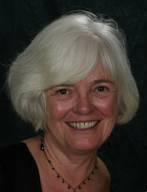
I feel blessed to count Ann Whitford Paul as a friend. She is one of the hardest working writers I've ever met and one of the best picture book writers around. She was a student of Myra Cohn Livingston's; poetry courses through the veins of every story Ann creates. On top of all that, she is a diligent reviser! So I asked her if she could give three revising tips for us. I think much of what she shares below applies to any kind of writing, not just picture book texts. Take it away, Ann!
Character is everything, especially these days when that’s what publishers are asking for. Make sure that yours have child appeal. Also don’t have a huge cast of characters. One or two is best, four, the maximum.
I discovered with the help of a fabulous consultation with Emma Dryden that naming a character is incredibly important. Changing Little Pig, Big Pig and Biggest-Pig-of all to Pattie, Mattie and Penelope somehow opened a door to their personalities. It inspired me to work to make sure each spoke in a different voice. For example, now Pattie always speaks the same word, “Nooooo.” Changing dog characters in another story from their breed names to something more distinctive such as Bulldog to Willie, Poodle to Francoise, Dalmatian to Dag and Chihuahua to Teacup was similarly helpful. Teacup is a squealer now and so excited that she often repeats words. I wouldn’t have thought of this change without coming up with the names. With both stories, the names themselves increased the humor in each. Spend time making sure that your names are the absolute best you can come up with. Play with lots of possibilities. Then let those names fill you in on character and revise to give your manuscript new life.
Also make sure that your characters aren’t perfect children. We all are imperfect. We all have strengths and weaknesses. Your characters should be the same. For example my character Willie in the story mentioned above loves to help. That’s good. The problem is that he’s too enthusiastic and goes overboard each time. When your characters are fully human (even if they’re animals) your reader will more easily identify with them and better yet, love them.
It seems obvious that as an author you should know what you want to say in your story and that your story expresses that concept. However, way too many stories meander without a core. They start with one problem and end up solving another. It’s critical that when you’re revising, you think about what you want the reader/listener to come away with after hearing your story.
When you’re revising it’s time, if you haven’t done it before, to state in one sentence what your story is about. Once that is done, you can check to make sure everything in the picture book relates to that sentence. Remember picture books introduce children to story. Therefore what you write can’t be complicated. Save those different plot twists and large casts of characters for your middle grade novel. Also create a story that has relevance for your audience. For example—your picture book listener has no interest in gathering data about the latest election polls. Neither does she care about the trials and tribulations of preparing for a first date.
Last of all . . . language, language, language. It is critically important that the language of your story expresses the sentiment and activity of your text. If you’re writing a good night book, stay away from words like pop and block. Don’t name your characters Kate or Dick. Don’t write short sentences with loud sounding words. All of those belong in a noisy book, an active book, a get-up and jump around tale.
During revisions consider each and every word. Would walk be better here than stroll? Can you add some onomatopoetic words like buzz and zip to your text? Kids love to “read” those words out loud. Consider each sentence. A long rambling sentence might work perfectly for description of a lazily flowing river, but would slow down the action of a chase scene. Remember picture books are the closest form of writing to a poem. Even though they don’t have to rhyme, they must be poetic. They must be written so the worst actress can read with comfort and expression. If the story works, but the language doesn’t, your manuscript will fail. Every word counts.
Ann Whitford Paul is the author of the award-winning Eight Hands Round, and All By Herself, as well as If Animals Kissed Goodnight, Word Builder, and a series of books with a Spanish language flair: Manana Iguana, Fiesta Fiasco, Count on Culebra and Tortuga in Trouble. She is also the author of the extremely useful and concise craft book, Writing Picture Books.
Published on November 30, 2012 07:00
November 29, 2012
Thursday's Thought
Just because you don't know everything doesn't mean you know nothing.
Karen Cushman, The Midwife's Apprentice
Karen Cushman, The Midwife's Apprentice
Published on November 29, 2012 07:30
November 27, 2012
Teacher Tuesday
<!-- /* Font Definitions */ @font-face {font-family:"Courier New"; panose-1:2 7 3 9 2 2 5 2 4 4; mso-font-charset:0; mso-generic-font-family:auto; mso-font-pitch:variable; mso-font-signature:3 0 0 0 1 0;} @font-face {font-family:Wingdings; panose-1:5 2 1 2 1 8 4 8 7 8; mso-font-charset:2; mso-generic-font-family:auto; mso-font-pitch:variable; mso-font-signature:0 0 65536 0 -2147483648 0;} @font-face {font-family:Calibri; panose-1:2 15 5 2 2 2 4 3 2 4; mso-font-charset:0; mso-generic-font-family:auto; mso-font-pitch:variable; mso-font-signature:3 0 0 0 1 0;} @font-face {font-family:Cambria; panose-1:2 4 5 3 5 4 6 3 2 4; mso-font-charset:0; mso-generic-font-family:auto; mso-font-pitch:variable; mso-font-signature:3 0 0 0 1 0;} /* Style Definitions */ p.MsoNormal, li.MsoNormal, div.MsoNormal {mso-style-parent:""; margin-top:0in; margin-right:0in; margin-bottom:10.0pt; margin-left:0in; mso-pagination:widow-orphan; font-size:12.0pt; font-family:"Times New Roman"; mso-ascii-font-family:Cambria; mso-fareast-font-family:Cambria; mso-hansi-font-family:Cambria; mso-bidi-font-family:"Times New Roman";} a:link, span.MsoHyperlink {color:blue; text-decoration:underline; text-underline:single;} a:visited, span.MsoHyperlinkFollowed {mso-style-noshow:yes; color:purple; text-decoration:underline; text-underline:single;} p.ColorfulList-Accent11, li.ColorfulList-Accent11, div.ColorfulList-Accent11 {mso-style-name:"Colorful List - Accent 11"; margin-top:0in; margin-right:0in; margin-bottom:10.0pt; margin-left:.5in; mso-add-space:auto; mso-pagination:widow-orphan; font-size:12.0pt; font-family:"Times New Roman"; mso-ascii-font-family:Cambria; mso-fareast-font-family:Cambria; mso-hansi-font-family:Cambria; mso-bidi-font-family:"Times New Roman";} p.ColorfulList-Accent11CxSpFirst, li.ColorfulList-Accent11CxSpFirst, div.ColorfulList-Accent11CxSpFirst {mso-style-name:"Colorful List - Accent 11CxSpFirst"; mso-style-type:export-only; margin-top:0in; margin-right:0in; margin-bottom:0in; margin-left:.5in; margin-bottom:.0001pt; mso-add-space:auto; mso-pagination:widow-orphan; font-size:12.0pt; font-family:"Times New Roman"; mso-ascii-font-family:Cambria; mso-fareast-font-family:Cambria; mso-hansi-font-family:Cambria; mso-bidi-font-family:"Times New Roman";} p.ColorfulList-Accent11CxSpMiddle, li.ColorfulList-Accent11CxSpMiddle, div.ColorfulList-Accent11CxSpMiddle {mso-style-name:"Colorful List - Accent 11CxSpMiddle"; mso-style-type:export-only; margin-top:0in; margin-right:0in; margin-bottom:0in; margin-left:.5in; margin-bottom:.0001pt; mso-add-space:auto; mso-pagination:widow-orphan; font-size:12.0pt; font-family:"Times New Roman"; mso-ascii-font-family:Cambria; mso-fareast-font-family:Cambria; mso-hansi-font-family:Cambria; mso-bidi-font-family:"Times New Roman";} p.ColorfulList-Accent11CxSpLast, li.ColorfulList-Accent11CxSpLast, div.ColorfulList-Accent11CxSpLast {mso-style-name:"Colorful List - Accent 11CxSpLast"; mso-style-type:export-only; margin-top:0in; margin-right:0in; margin-bottom:10.0pt; margin-left:.5in; mso-add-space:auto; mso-pagination:widow-orphan; font-size:12.0pt; font-family:"Times New Roman"; mso-ascii-font-family:Cambria; mso-fareast-font-family:Cambria; mso-hansi-font-family:Cambria; mso-bidi-font-family:"Times New Roman";} @page Section1 {size:8.5in 11.0in; margin:1.0in 1.25in 1.0in 1.25in; mso-header-margin:.5in; mso-footer-margin:.5in; mso-paper-source:0;} div.Section1 {page:Section1;} /* List Definitions */ @list l0 {mso-list-id:1089498211; mso-list-type:hybrid; mso-list-template-ids:-1207541140 67698689 67698691 67698693 67698689 67698691 67698693 67698689 67698691 67698693;} @list l0:level1 {mso-level-number-format:bullet; mso-level-text:; mso-level-tab-stop:none; mso-level-number-position:left; text-indent:-.25in; font-family:Symbol;} ol {margin-bottom:0in;} ul {margin-bottom:0in;} </style> <br /><div class="MsoNormal"><span style="font-size: large;"><span style="font-family: Georgia,"Times New Roman",serif;">I can't wait to meet Jen Vincent in person, though I've had fun getting to know her through her Nerdy Book Club posts and through her <a href="http://www.teachmentortexts.com/"... (co-written with future Teacher T<span style="font-size: large;">uesday-er, Kellee Mo<span style="font-size: large;">ye)<span style="font-size: large;">. </span></span></span></span></span><br /><br /><span style="font-size: large;"><span style="font-family: Georgia,"Times New Roman",serif;"><span style="font-size: large;"><span style="font-size: large;"><span style="font-size: large;">Jen has worked in special education<span style="font-size: large;"><span style="font-size: large;"> for<span style="font-size: large;"> the last ten<span style="font-size: large;"> years, traveling to seven differen<span style="font-size: large;">t schools to teach students who are deaf and har<span style="font-size: large;">d of hearing and are mainstre<span style="font-size: large;">amed into regular education classes. This year, s<span style="font-size: large;">he's working as a teacher leader f<span style="font-size: large;">or her school district. She<span style="font-size: large;">'s teamed up with another teacher <span style="font-size: large;">to take charge of the Teacher Mentor <span style="font-size: large;">Program, leading the professi<span style="font-size: large;">onal development for all new teachers and their mentors. Her school <span style="font-size: large;">district is the seco<span style="font-size: large;">nd largest in Illinois, with over 50 schools<span style="font-size: large;"> serving earl<span style="font-size: large;">y childhood (preschool) through high school. </span></span></span></span></span></span></span></span></span></span></span></span></span></span></span></span></span></span></span></span></span></span><br /></div><div class="MsoNormal"><span style="font-size: large;"><span style="font-family: Georgia,"Times New Roman",serif;">When I think "passionate about books<span style="font-size: large;"><i>,</i></span>" I think of Jen! <span style="font-size: large;">So, p</span>our yourself a cup of cozy chamomile tea and meet this amazing teacher<span style="font-size: large;">, starting</span> off with a peek at her past! (Sorry, no photo. She wasn't able to snag one while home for the Thanksgiving holiday. But don't you just know she was darling<span style="font-size: large;">?!</span>) </span></span></div><ul><li><span style="font-size: large;"><span style="font-family: Georgia,"Times New Roman",serif;"><span style="-moz-font-feature-settings: normal; -moz-font-language-override: normal; font-size-adjust: none; font-size: large; font-stretch: normal; font-style: normal; font-variant: normal; font-weight: normal; line-height: normal;"></span><i>Favorite school lunch as a kid:</i> My mom used to pack peanut butter and honey sandwiches for me! Sticky and sweet and delicious.</span></span><span style="font-size: large;"><span style="font-family: Georgia,"Times New Roman",serif;"><b> </b></span></span></li><li><span style="font-size: large;"><span style="font-family: Georgia,"Times New Roman",serif;"><i>Best friend in grade school:</i> Alicia moved near me in 2<sup>nd</sup> grade. We rode the bus together and rode our bikes back and forth to each other’s houses all the time.</span></span></li><li><span style="font-size: large;"><span style="font-family: Georgia,"Times New Roman",serif;"></span></span><span style="font-size: large;"><span style="font-family: Georgia,"Times New Roman",serif;"><i>Times you were the new kid in school:</i> I was never the new kid in school! I was lucky enough to live in the same town all through school. There were lots of times I secretly wished I could move and be the new kid just because I thought it would be great to start over and meet new people.</span></span><span style="font-size: large;"><span style="font-family: Georgia,"Times New Roman",serif;"><b> </b></span></span></li><li><span style="font-size: large;"><span style="font-family: Georgia,"Times New Roman",serif;"><i>Teacher who inspired you to stretch: </i>I had lots of great and memorable teachers but Ms. Urkovich was one of my English teachers in high school who inspired me to stretch. I had her for Composition, and later, British Literature. She was intense and made me think about reading and writing like I never had before. She was the perfect example of a teacher who was hardcore and serious about learning but who really cared at the same time. I respected her for pushing me.</span></span><span style="font-size: large;"><span style="font-family: Georgia,"Times New Roman",serif;"><b> </b></span></span></li><li><span style="font-size: large;"><span style="font-family: Georgia,"Times New Roman",serif;"><i>The one thing you always wished you could do in grade school but never achieved:</i> I could never climb to the top of the rope in PE class. Never. That always bothered me. I did, however, make a basket that brought my whole team back into the game one time when we played Bombardment (it’s like Dodgeball). I’m very proud of that moment!</span></span></li></ul><br /><div class="ColorfulList-Accent11CxSpMiddle" style="line-height: 150%; mso-list: l0 level1 lfo1; text-indent: -.25in;"><br /></div><div class="ColorfulList-Accent11CxSpMiddle" style="line-height: 150%; margin-left: 0in; mso-add-space: auto;"> <span style="font-size: large;"><span style="font-family: Georgia,"Times New Roman",serif;"><i>Okay, now let's get to the juicy bits<span style="font-size: large;"> of the interview</span>. Jen, you have a passion for “building community around books.” </i></span></span><i><span style="mso-bidi-font-weight: normal;"><span style="font-size: large;"><span style="font-family: Georgia,"Times New Roman",serif;">Why does having a community built around books matter?</span></span></span></i><b style="mso-bidi-font-weight: normal;"> </b></div><div class="ColorfulList-Accent11CxSpMiddle" style="line-height: 150%; margin-left: 0in; mso-add-space: auto;"><br /></div><div class="ColorfulList-Accent11CxSpMiddle" style="line-height: 150%; margin-left: 0in;"><span style="font-size: large;"><span style="font-family: Georgia,"Times New Roman",serif;">I think most readers – whether they are kids or adults – love to talk about what books they are reading…and we probably don’t ever get enough time to talk about books. Developing respect and rapport with others, in or out of the classroom, is essential for learning in school and in life. If we talk about books and share books we love, it’s a great way to develop that relationship but also to establish a community that can learn together. Using books as a way to develop such a community is perfect. As a teacher, I believe students in a class should feel this sense of learning and excitement about literacy. But why shouldn’t they feel that same sense of community of literacy in an entire school and even an entire district? If we hope to encourage students to be lifelong readers, doesn’t it make sense that we show them how adults everywhere in their school, in their entire district, in their community are lifelong readers themselves? </span></span></div><div class="ColorfulList-Accent11CxSpMiddle" style="line-height: 150%; margin-left: 0in;"><br /></div><div class="ColorfulList-Accent11CxSpMiddle" style="margin-left: 0in;"><span style="font-size: large;"><span style="font-family: Arial,Helvetica,sans-serif;"><i><span style="font-family: Georgia,"Times New Roman",serif;">When we <span style="font-size: large;">e-chatted, you</span> shared <span style="font-size: large;">your belie<span style="font-size: large;">f </span></span>that books “magically connect people of all ages, across time and place.” Can you talk more about that? Give us some examples of where you’ve seen that happen. </span></i> </span></span></div><div class="ColorfulList-Accent11CxSpMiddle" style="margin-left: 0in;"><br /></div><div class="ColorfulList-Accent11CxSpMiddle" style="margin-left: 0in;"><span style="font-family: Georgia,"Times New Roman",serif;"><span style="font-size: large;">Over the summer, I read <i>On Writing </i>by Stephen King and he talked about how writing is like a time machine that links the writer with the reader. The author writes words and builds a story – characters, setting, plot – and the reader gets that story kind of like osmosis when he or she reads it. It kind of is like magic. We have books that tell stories that people read years ago and that we still read today. Look at Colby Sha<span style="font-size: large;">rp </span>and John Schu <a href="http://mrschureads.blogspot.com/2011/... through all the Newbery winners, <span style="font-size: large;"><span style="font-size: large;">as if t<span style="font-size: large;">hey were kid readers from <span style="font-size: large;">1922, or '32, or '42</span>.</span></span></span></span></span> <span style="font-size: large;"><br /></span><br /><br /><span style="font-family: Georgia,"Times New Roman",serif;"><span style="font-size: large;">At the same time, there are books that readers young and old enjoy. Books like <i>Harry Potter </i>and <i>The Hunger Games </i>that are as wildly popular with young adult readers as they are with adults. This year, one of my students read <i>Wonder </i>by RJ Palacio. Her mother also read the book and it was great for them to share the book together. What’s really amazing is that technology has now made it more evident than ever that readers around the world are reading similar books. </span></span><br /><br /><span style="font-family: Georgia,"Times New Roman",serif;"><span style="font-size: large;"><span style="font-size: large;">For example, </span>I reviewed Jon Klassen’s newest picture book <i>This Is Not My Hat </i>and a Twitter friend in Germany told me how it wasn’t going to be available to her for another month or two. She was antsy with anticipation and wishing she didn’t have to wait. It’s amazing to think of the friends I have on Twitter all over the world because of our shared love of books. Finding someone who loves a book you love is kind of like finding someone who grew up where you grew up or went to college where you went to college. For me, sharing books with someone is like drinking insta-friend – it cuts through time, age and place. It truly is book magic.</span></span></div><div class="ColorfulList-Accent11CxSpMiddle" style="margin-left: 0in;"><br /></div><div class="ColorfulList-Accent11CxSpMiddle" style="line-height: 150%; margin-left: 0in;"><i><span style="font-family: Georgia,"Times New Roman",serif;"><span style="font-size: large;">What are some of the steps involved building a community around books? </span></span></i><br /><br /><span style="font-family: Georgia,"Times New Roman",serif;"><span style="font-size: large;">There are lots of things <span style="font-size: large;">that can</span> build community around books and they all depend on a teacher’s comfort level and knowledge of books. For me, the place to start is to really embrace reading children’s or young adult literature. Teachers shouldn’t be ashamed to read what their students are reading. I would suggest teachers talk to students about books they love or seek out the school or public librarian to ask for current titles appropriate to the age/grade level of students they teach. <span style="font-size: large;">C</span>hoose one that appeals to you and dive in<span style="font-size: large;">!</span> The community part comes from sharing this book with the students. Teachers could have a place where they display what book they are reading. Teachers can give kids time to share what <i>they</i> are reading – this could be time to meet in partners or small groups or a bulletin board where kids can celebrate what they have read. I recommend reading Donalyn Miller’s <i>The Book Whisperer</i> or Stephen Layne’s <i>Igniting a Passion for Reading</i>. Both are excellent resources with ideas for building a reading community. </span></span></div><div class="ColorfulList-Accent11CxSpMiddle" style="margin-left: 0in;"><span style="font-size: large;"><span style="font-family: Georgia,"Times New Roman",serif;"><i>Talk a bit about what happens when you talk about books with students.</i><b> </b></span></span><br /><br /><span style="font-size: large;"><span style="font-family: Georgia,"Times New Roman",serif;">It’s amazing how students open up when I ask them about books. The very first time, it’s almost as if they are surprised that I know a lot of the books they have read, but then they get excited and start sharing what books they love or why they love them. It’s pretty easy to tell which kids don’t read much because their eyes get wide and they seem stuck when it comes to being able to talk about books. It’s safe to say I haven’t read every book that exists so there is usually a book or two kids will recommend to me that I’ve never read before, and that’s awesome, too! I love when kids can tell me about books I should read. </span></span></div><div class="ColorfulList-Accent11CxSpMiddle" style="margin-left: 0in;"><span style="font-size: large;"><span style="font-family: Georgia,"Times New Roman",serif;"><br /></span></span></div><div class="ColorfulList-Accent11CxSpMiddle" style="margin-left: 0in;"><i><span style="font-size: large;"><span style="font-family: Georgia,"Times New Roman",serif;">Talk a bit about what happens when they talk books with you. </span></span></i><br /><br /><span style="font-size: large;"><span style="font-family: Georgia,"Times New Roman",serif;">As I said above, it kind of depends on the child/tween/teen. If he or she knows books, then we start going back and forth and sharing titles. If he or she doesn’t know books well, then they might ask questions about the book I share or sometimes they do seem to stop and search their minds for a book to share. In general, I would say kids love to show what they know, so they try to engage in the conversation…and I just love that the conversation gets to be about books. </span></span></div><div class="ColorfulList-Accent11CxSpMiddle" style="margin-left: 0in;"><span style="font-size: large;"><span style="font-family: Georgia,"Times New Roman",serif;"><br /></span></span></div><div class="ColorfulList-Accent11CxSpMiddle" style="margin-left: 0in;"><i><span style="font-size: large;"><span style="font-family: Georgia,"Times New Roman",serif;">Let’s say I’m not a teacher or librarian. Just a plain old adult. But I want to encourage my niece or nephew or neighbor to read. Can you give me some suggestions about book talking and book sharing that might help?</span></span></i><br /><br /><span style="font-size: large;"><span style="font-family: Arial,Helvetica,sans-serif;"><span style="font-size: large;"><span style="font-family: Georgia,"Times New Roman",serif;">I honestly believe people (not just kids) are particular about what books they read. I almost said picky, that’s almost the right word, but I think particular is better. There are some books we would hesitate or refuse to pick up, but others that we can’t get enough of. The first step, in my mind, is to figure out what this niece or nephew <i>like<span style="font-size: large;">s</span></i> to read. Ask what he or she has read lately, what movies he or she has seen and loved lately, what he or she is in the mood for. From there, I would recommend a special outing either to the library or to a bookstore (independent is even better). I know my kids like to have special <span style="font-size: large;">M</span>om and <span style="font-size: large;">D</span>ad time, and making a special trip to look for books it always fun for us. Sometimes we get a hot chocolate or a smoot<span style="font-size: large;">h</span>ie afterwards (depending on the season) and read our books…pairing books with treats is a fun activity. I guess the answer would be showing them that you are interested in what they read, helping them find books they would like, and then making it into a special bonding time to hang out and talk about books.<span style="font-size: large;"> It’s as much the experience as it is</span></span><span style="font-family: Georgia,"Times New Roman",serif;"> the book – which kind of ties into reading communities in a classroom!</span></span></span></span></div><div class="ColorfulList-Accent11CxSpMiddle" style="margin-left: 0in;"><span style="font-size: large;"><span style="font-family: Georgia,"Times New Roman",serif;"><br /></span></span></div><div class="ColorfulList-Accent11CxSpMiddle" style="margin-left: 0in;"><span style="font-size: large;"><span style="font-family: Georgia,"Times New Roman",serif;"><i>How could “book communities” help readers sample genres outside those they normally are drawn to?</i><b> </b> </span></span><br /><br /><span style="font-size: large;"><span style="font-family: Georgia,"Times New Roman",serif;">As I just said, readers can be particular about what they like. But people in general also like to feel part of a community and connected with others. When we create this great community of readers, it’s natural for readers to share books, and then it becomes normal for kids to want to read what others are reading. Since we all have different tastes, we aren’t always going to share the same books. This is where the power of community comes in. As we see what others are reading, it prompts us to try a book that might be outside of our normal or beloved genres. </span></span></div><div class="ColorfulList-Accent11CxSpMiddle" style="margin-left: 0in;"><span style="font-size: large;"><span style="font-family: Georgia,"Times New Roman",serif;"><br /></span></span></div><div class="ColorfulList-Accent11CxSpMiddle" style="margin-left: 0in;"><span style="font-size: large;"><span style="font-family: Georgia,"Times New Roman",serif;"><i>What are some of the different ways you share your favorite books with your students? What are some of the ways you extend the book through activities like art projects, etc?</i></span></span><br /><br /><span style="font-size: large;"><span style="font-family: Georgia,"Times New Roman",serif;">I love taking pictures with books! When I was teaching, my students always brought a book with them. They would take a picture with their book and I would take a picture with my book and then we would share what we were reading. I would also bring in stacks of books to book talk or for them to preview when I knew they were almost done reading a book. We also would add to their To-Be-Read lists as we discovered books to read in the future. Fun art projects depend on what strikes me when I read a book. My favorite book<span style="font-size: large;">-extension</span> activities come from <i><a href="http://www.happybirthdayauthor.com/&q... Birthday, Author</a><span style="font-size: large;"><span style="font-size: large;">, </span></span></i><span style="font-size: large;"><span style="font-size: large;">by<span style="font-size: large;"><i> </i>Er<span style="font-size: large;">ic VanRaepenbusch</span></span></span></span></span></span>. I love all of <span style="font-size: large;">his </span>ideas. <span style="font-size: large;">Often,</span> I would bring in snacks that related to a book with my students. We would talk about books, listen as I read aloud or book<i><span style="font-size: large;"><span style="font-family: Arial,Helvetica,sans-serif;">-</span></span></i>talked while having a book-related snack. </div><div class="ColorfulList-Accent11CxSpMiddle" style="margin-left: 0in;"><span style="font-size: large;"><span style="font-family: Georgia,"Times New Roman",serif;"><br /></span></span></div><div class="ColorfulList-Accent11CxSpMiddle" style="margin-left: 0in;"><span style="font-size: large;"><span style="font-family: Georgia,"Times New Roman",serif;"><i>What has most surprised you in your efforts to build a book community where you live and teach?</i><b> </b> </span></span><br /><br /><span style="font-size: large;"><span style="font-family: Georgia,"Times New Roman",serif;">I’m always surprised when teachers or parents aren’t familiar with current titles in kidlit for their students or children. I don’t know if I will ever get used to that<span style="font-size: large;">;</span> for now, I just get over it. I make it my focus to introduce people to new titles or new authors or new genres. I think any parent of a preschool- through elementary-aged child should know Mo Willems and at least one of the many books he has contributed to children’s literature. I don’t care how old you are, his books are endearing and hysterical. When I hear of a book that I don’t recognize at all, that’s a great surprise. I love learning about new books. </span></span></div><div class="ColorfulList-Accent11CxSpMiddle" style="margin-left: 0in;"><span style="font-size: large;"><span style="font-family: Georgia,"Times New Roman",serif;"><br /></span></span></div><div class="ColorfulList-Accent11CxSpMiddle" style="margin-left: 0in;"><span style="font-size: large;"><span style="font-family: Georgia,"Times New Roman",serif;"><i>How can the different components of the book world – authors, illustrators, editors, publishers, agents, booksellers, librarians – work more cohesively together to help build a community around books? </i></span></span><br /><br /><span style="font-size: large;"><span style="font-family: Georgia,"Times New Roman",serif;">Twitter and blogs have opened the door to this community! It’s so exciting<i><span style="font-size: large;">.</span></i> I love being able to reach out to people who live in different parts of the book world <span style="font-size: large;">but are only an</span> e-mail, tweet, or blog post away. It’s pretty amazing<span style="font-size: large;">!</span> When I was a kid, I remember feeling like authors were old people <span style="font-size: small;"><i>[ed note: I'm not that old!] </i></span><i><span style="font-size: large;"></span></i>who lived far fro<span style="font-size: large;">m me</span> and to whom I could send a snail mail letter but probably wouldn’t get a respons<span style="font-size: large;">e. T</span>hanks to blogs and Twitter, that whole impression has changed. We have so many am<span style="font-size: large;">az<span style="font-size: large;">ing</span></span> ways to be connected. Any time an author, illustrator, editor, publisher, editor, bookseller, librarian, or reader can use and embrace technology in a way to build this sense of community makes a big difference. It still blows my mind when I post a review or tweet about a book and the author or publisher responds or contacts me. It’s crazy. Any of those people in that list of book world citizens you mentioned are complete celebrities to me. Technology has helped me feel so much more connected and so much more part of this fun book world because of the ease with which we can reach out to each other.</span></span></div><div class="ColorfulList-Accent11CxSpMiddle" style="margin-left: 0in;"><span style="font-size: large;"><span style="font-family: Georgia,"Times New Roman",serif;"><br /></span></span></div><div class="ColorfulList-Accent11CxSpMiddle" style="margin-left: 0in;"><span style="font-size: large;"><span style="font-family: Georgia,"Times New Roman",serif;"><i>Have you heard about that project, <a href="http://littlefreelibrary.org/"&g... Free Libraries</a>? The spirit of this project was the first thing I thought of when you proposed this topic. Have you heard of other ways communities have come together to spread the love of books and reading? </i></span></span><br /><br /><span style="font-size: large;"><span style="font-family: Georgia,"Times New Roman",serif;">I have! They are so cute! I would love to have one but I’m not handy nor is my husband (and they are kind of expensive…). Maybe someday. I love the school that created the video with the song <i>Gotta Keep Reading</i>. </span></span><br /><br /><object class="BLOGGER-youtube-video" classid="clsid:D27CDB6E-AE6D-11cf-96B8-444553540000" codebase="http://download.macromedia.com/pub/sh..." data-thumbnail-src="http://2.gvt0.com/vi/GNpNfhpqDk4/0.jpg" height="266" width="320"><param name="movie" value="http://www.youtube.com/v/GNpNfhpqDk4&..." /><param name="bgcolor" value="#FFFFFF" /><param name="allowFullScreen" value="true" /><embed width="320" height="266" src="http://www.youtube.com/v/GNpNfhpqDk4&..." type="application/x-shockwave-flash" allowfullscreen="true"></embed></object><span style="font-size: large;"><span style="font-family: Georgia,"Times New Roman",serif;">I remember seeing it on Oprah and thinking it looked like a blast! I have found some of the most dedicated educators on Twitter who share a love of books and reading. Earlier this year, Nerdy Book Club sponsored the <a href="http://nerdybookclub.wordpress.com/20... For President Photo Contest</a>. That was phenomenal. It was so much fun to be a participant (and a winner!). On our blog, Kellee Moye and I host the kidlit/YA version of the <a href="http://www.teachmentortexts.com/2012/... Monday What Are You Reading?</a> meme. That has turned into quite a community of awesome bloggers who share what they are reading and reviewing. We love sharing what we are reading and seeing what others are reading through this meme. It’s all great<i><span style="font-size: large;">.</span></i></span></span></div><div class="ColorfulList-Accent11CxSpLast" style="margin-left: 0in;"><span style="font-size: large;"><span style="font-family: Georgia,"Times New Roman",serif;"><br /></span></span></div><div class="MsoNormalCxSpFirst"><span style="font-size: large;"><span style="font-family: Georgia,"Times New Roman",serif;"><i>What else would you like to say about the power of talking about books/sharing books/building a community around books?</i><b> </b> </span></span><br /><br /><span style="font-size: large;"><span style="font-family: Georgia,"Times New Roman",serif;">I simply want to reiterate how important it is to share books with everyone – children and adults. We learn about ourselves, about others, and about the world through reading. Sometimes we read to find ourselves and our experiences in books and sometimes we read to understand feelings or experiences we might never have. No matter why we read, reading is important. Adults need to model reading for kids and then also model what it means to be a reader who shares books and talks about books. We all have our own circles of influence. No matter how big or how small, we do make a difference, and if we can encourage or inspire anyone within that circle to pick up a book and read, then we’ve had an influence. </span></span></div><br /><span style="font-family: Georgia,"Times New Roman",serif;"><br /></span><span style="font-family: Georgia,"Times New Roman",serif;"><i><span style="font-size: large;">Can yo<span style="font-size: large;">u see why these Teacher Tuesday interviews have me<span style="font-size: large;"> so charged up?! Wow! Jen -- you rock. Thank you for all you <span style="font-size: large;">do to build <span style="font-size: large;">community around<span style="font-size: large;"> <span style="font-size: large;">stories. I feel so proud of all the teachers<span style="font-size: large;"> and librarians<span style="font-size: large;"> like you<span style="font-size: large;">, who are out there every day connecting kids and books<span style="font-size: large;">. What a wo<span style="font-size: large;">nde<span style="font-size: large;">rful world<span style="font-size: large;"> this is, with people like you!</span></span></span></span></span></span></span></span></span></span></span></span></span></span></i></span><div class="blogger-post-footer"><img width='1' height='1' src='https://blogger.googleusercontent.com...' alt='' /></div>
Published on November 27, 2012 07:00
November 23, 2012
Friend Friday
How many people do you know who are members of the National Puzzlers' League? I only know one: Eric Berlin. I met Eric at the Truman State Literature Festival in Kirksville, Missouri last fall, and fell in love with his Winston Breen series. They are a bit like Encyclopedia Brown meets Will Shortz. As a crossword puzzle fan, I've found the books irresistible. What I love best, however, is that the mystery is not a footnote in these stories. There's something at stake and it's meaningful, in each of the books.
This is Eric's newest.
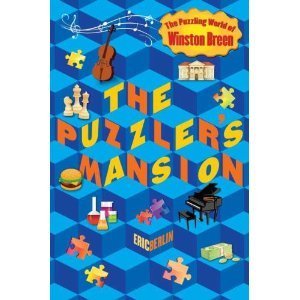
You'll want to add it to your home or school library. Today!
This is Eric's newest.

You'll want to add it to your home or school library. Today!
Published on November 23, 2012 07:00



